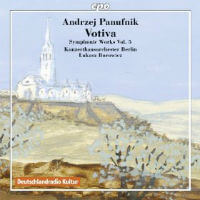
By the 1940s Panufnik amassed a considerable catalog of works, only to see them destroyed in WWII Poland. Postwar, Panufnik would not accept the yoke of Socialist Realism and thus was blacklisted. He escaped from Poland in 1954 and saw his name and music totally censored for 25 years. While fellow Poles Lutoslawski, Penderecki and Gorecki established their international reputations, Panufnik settled in England as a conductor. It took most of the 60s for his compositions to be recognized again.
Thus the importance of this series from Lukas Borowicz on CPO, which brings fresh readings of his 10 Symphonies and assorted shorter works. Volume V provides a welcome second recording of one of his most successful later symphonies, the “Votiva,” and “Metasinfonia”—long unavailable on disc.
Much of the appeal of Panufnik’s music is in his exploration and celebration of spirituality through the mystery and logical beauty of geometrical patterns. This is music that unfolds slowly via repetition, subtle changes in color, incremental expansion, retrograde motion, and logical sequence.
1978’s Symphony No. 7, “Metasinfonia,” is a prime example of Panufnik’s geometric inspired compositions. The work is laid out in 2 spirals, the first part starting at the edge and contracting towards the center; imagine a spiral galaxy. The second part of the work retraces the journey back to the outer edges, flirting with disorder. Scored for strings, organ and timpani, “Metasinfonia” is a bit dry, cold and mechanical; it may take a mathematician’s mind to really appreciate the subtle and logical progression of the work. The committed soloists and the fine work by Borowicz and his orchestra offer what is the definitive recording of this elusive piece by keeping it flowing along, never letting it descend to total stasis. The excellent sonics demonstrate Panufnik’s ability to wring subtle shades of color from a limited palette. The only other recording, a Panufnik/LSO Unicorn recording, has never made it to CD.

“Votiva” has fared well on CD. Ozawa and the Boston Symphony recorded the work for Hyperion (coupled with the fascinating Sessions Concerto for Orchestra) soon after the premiere. This was the only version until IMP BBC Radio Classics issued a live Proms performance in 1995 with the BBC Symphony under the composer’s direction. The Ozawa is still in print under the budget Helios label, the Panufnik sadly has not been in print for years. Ozawa takes the work at a brisk clip, losing much of the hushed reverence and slowly evolving climax of the first section. Panufnik takes the work at its slowest pace (27 min, with Ozawa at 22 and Borowicz at 25) but best captures the intensity of the work. Borowicz benefits from excellent sound and excellent playing. Certainly the recommended version, but if you can find the Panufnik, its more slowly unfolding tempo brings out the drama in this most evocative work.
The concluding Concerto Festivo is a 3-movement concerto for orchestra using all the composer’s trademarks: percussive outbursts, string chorales, and brilliant brass. Colorful and exciting, Concerto Festivo, written for the 75th anniversary of the London Symphony Orchestra, is a fine pièce d’occasion contrast to the heavier symphonies.
Andrzej Panufnik Symphonic Works v 5
Metasinfonia (#7) for Organ, Timpani and Strings (1978)
Sinfonia Votiva (#8) for Orchestra (1982)
Concerto Festivo for Orchestra (1979)
Jörg Strodthoff, Organ; Michael Oberaigner, Timpani
Lukas Borowicz Konzerthausorchester Berlin
CPO 777 684-2 November 2012 | Buy it on Amazon
–
Don Clark is a classical music enthusiast, free lance concert reviewer and blogger. Follow him on Twitter: @Donaldopato.

